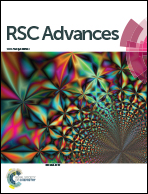A facile synthesis of nanostructured CoFe2O4 for the electrochemical sensing of bisphenol A†
Abstract
This work reports a novel, highly sensitive and cost-effective electrochemical sensor for the detection of bisphenol A in environmental water samples. Attractive non-noble transition metal oxide CoFe2O4 nanoparticles were successfully synthesized using a sol–gel combustion method and further characterized by X-ray diffraction, scanning electron microscopy and X-ray photoelectron spectroscopy. Under optimal conditions, the CoFe2O4 nanoparticle modified glassy carbon electrode exhibits high electrochemical activity and good catalytic performance for the detection of bisphenol A. The linear calibration curves are obtained within a wide concentration range from 0.05 μmol L−1 to 10 μmol L−1, and the limit of detection is 3.6 nmol L−1 for bisphenol A. Moreover, this sensor also demonstrates excellent reproducibility, stability, and good anti-interference ability. The sensor was successfully applied to determine bisphenol A in practical samples, and the satisfactory recovery rate was between 95.5% and 102.0%. Based on the great electrochemical properties and practical application results, this electrochemical sensor has broad application prospects in the sensing of bisphenol A.



 Please wait while we load your content...
Please wait while we load your content...